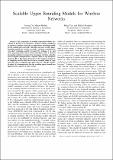Scalable upper bounding models for wireless networks
Author(s)
Du, Jinfeng; Medard, Muriel; Xiao, Ming; Skoglund, Mikael
DownloadScalable-Upper-Bounding.pdf (138.5Kb)
OPEN_ACCESS_POLICY
Open Access Policy
Creative Commons Attribution-Noncommercial-Share Alike
Terms of use
Metadata
Show full item recordAbstract
The framework of network equivalence theory developed by Koetter et al. introduces a notion of channel emulation to construct noiseless networks as upper/lower bounding models for the original noisy network. This paper presents scalable upper bounding models for wireless networks, by firstly extending the “one-shot” bounding models developed by Calmon et al. and then integrating them with network equivalence tools. A channel decoupling method is proposed to decompose wireless networks into decoupled multiple-access channels (MACs) and broadcast channels (BCs). The main advantages of the proposed method is its simplicity and the fact that it can be extended easily to large networks with a complexity that grows linearly with the number of nodes. It is demonstrated that the resulting upper bounds can approach the capacity in some setups.
Date issued
2014-06Department
Massachusetts Institute of Technology. Department of Electrical Engineering and Computer Science; Massachusetts Institute of Technology. Research Laboratory of ElectronicsJournal
Proceedings of the 2014 IEEE International Symposium on Information Theory
Publisher
Institute of Electrical and Electronics Engineers (IEEE)
Citation
Du, Jinfeng, Muriel Medard, Ming Xiao, and Mikael Skoglund. “Scalable Upper Bounding Models for Wireless Networks.” 2014 IEEE International Symposium on Information Theory (June 2014).
Version: Author's final manuscript
ISBN
978-1-4799-5186-4